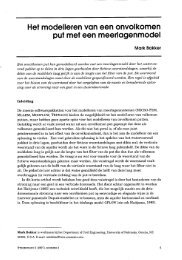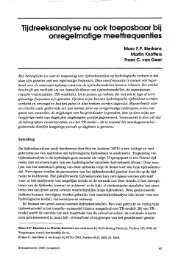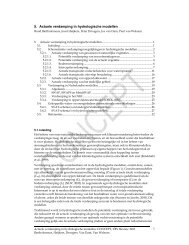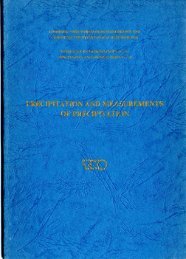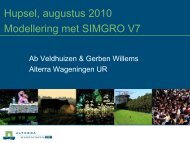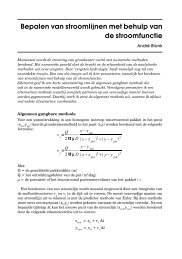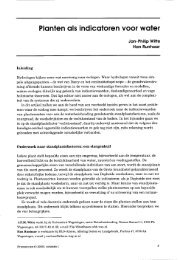Hydro-ecological relations in the Delta Waters
Hydro-ecological relations in the Delta Waters
Hydro-ecological relations in the Delta Waters
Create successful ePaper yourself
Turn your PDF publications into a flip-book with our unique Google optimized e-Paper software.
and this resulted <strong>in</strong> an almost complete ba~e soil. The hatched<br />
vegetation types changed much more gradually, without dy<strong>in</strong>g off<br />
totally. After <strong>the</strong> enclesure <strong>in</strong> most areas %he water was pemnently<br />
fixed more or lee$ at mean sea-level (%L).<br />
The follow<strong>in</strong>g aifferences<br />
occuted. In <strong>the</strong> fresh and brackish tidal areas <strong>the</strong> oris<strong>in</strong>al marsh<br />
vegetation c m at a mu&<br />
MLW)<br />
lower level (on certa<strong>in</strong> places even below<br />
than <strong>in</strong> <strong>the</strong> sal<strong>in</strong>e systems. Coneequently a larger area of here<br />
soils eraerged after <strong>the</strong> completion af <strong>the</strong> dams <strong>in</strong> <strong>the</strong> ffaltwater systems<br />
<strong>in</strong> comparison to <strong>the</strong> upstream tidalwaters. This difference is enlarged<br />
bp <strong>the</strong> dy<strong>in</strong>g off 09 <strong>the</strong> lower saltmarsh species <strong>in</strong> <strong>the</strong> first years<br />
after <strong>the</strong> enclosure. Vegetation development on <strong>the</strong> former salt marshes<br />
and tide1 flats uas dom<strong>in</strong>ated by colonisation of <strong>the</strong> new habitets by<br />
mnual pionier species. On <strong>the</strong> contrary, <strong>in</strong> <strong>the</strong> fresh and brackish<br />
areas <strong>the</strong> new species (that had to <strong>in</strong>vade exist<strong>in</strong>g vegetatians) were<br />
m&dy tall peremial herbs and grasses, shrubs and trees.<br />
3.2 Processes abimie eavironntent<br />
After <strong>the</strong> welesure ~.f an estsarg a nlrmber of precesnes started<br />
thang<strong>in</strong>g ahiotic environment of <strong>the</strong> new tcrrestr-ial environments (e..g.<br />
A<br />
PERtOUTINB SOIL<br />
--<br />
B YllL WITH IMRRWE8BLE M W<br />
Figure 7<br />
Twa ma<strong>in</strong> groundwater regimes on <strong>the</strong> newly emerged land <strong>in</strong> <strong>the</strong><br />
former estnaries (after Drost and Visser, 1981)





